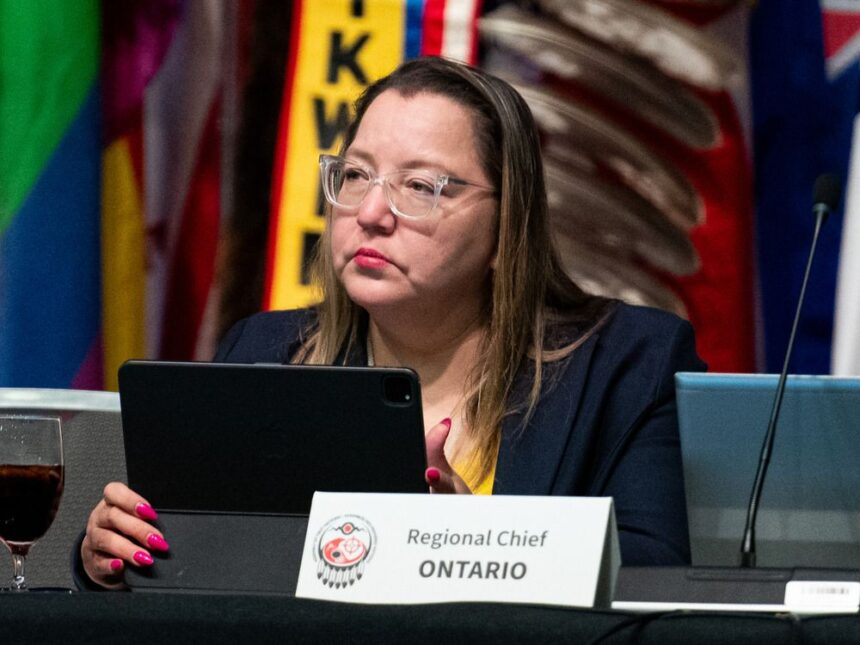The whispers inside Ottawa’s halls of power finally reached a crescendo this week as Assembly of First Nations National Chief Cindy Woodhouse Nepinak declared that Indigenous communities need more than just promises when it comes to Mark Carney’s controversial major projects legislation.
Standing before a gathering of First Nations leaders from across the country, Woodhouse Nepinak made it clear that Tuesday’s summit marked only the beginning of what promises to be extensive consultations between Indigenous communities and the federal government.
“We will not be rushed through this process,” she told the assembled delegates, many of whom traveled thousands of kilometers to voice concerns about the proposed legislation. “First Nations have been down this road before, where promises of prosperity somehow never seem to reach our communities.”
The summit, which brought together more than 200 chiefs and representatives, came in response to growing anxiety about the Trudeau government’s plans to streamline approvals for major resource and infrastructure projects—an initiative closely associated with Carney, the former Bank of Canada governor now positioning himself as a Liberal Party heavyweight.
According to sources at the gathering, many First Nations leaders expressed frustration that they weren’t adequately consulted before the government began floating the proposal. This sentiment was echoed by Chief Terry Paul of Membertou First Nation in Nova Scotia, who observed that “consultation after the fact isn’t consultation at all.”
What’s particularly striking about the summit was the diversity of perspectives. While some First Nations leaders see potential economic benefits in streamlining project approvals, others fear a return to the days when major developments proceeded with little regard for Indigenous rights or environmental concerns.
“We’ve seen projects race through approvals only to leave our lands scarred and our people with nothing but broken promises,” said one chief from British Columbia, where pipeline conflicts have repeatedly pitted resource development against Indigenous territorial claims.
The proposed legislation, still in its preliminary stages, aims to create what Carney has called “a predictable path to yes” for projects deemed in the national interest. But many Indigenous leaders at the summit questioned whose interests would truly be served.
Data from the Assembly of First Nations suggests that while resource development has generated billions in revenue across Canada, First Nations communities often see minimal economic benefits. A 2022 study found that unemployment in First Nations communities near major resource projects still averaged 19.1 percent—nearly triple the national rate.
Woodhouse Nepinak emphasized that any legislation must respect the principle of free, prior, and informed consent as outlined in the United Nations Declaration on the Rights of Indigenous Peoples, which Canada has committed to implement through its own legislation passed in 2021.
“This isn’t about saying no to development,” she clarified. “It’s about having a meaningful seat at the table where decisions about our territories are made.”
The federal response has been measured. Natural Resources Minister Jonathan Wilkinson, who attended part of the summit, acknowledged the concerns while defending the government’s approach.
“We understand the need for proper consultation,” Wilkinson said. “But we also need to recognize that regulatory uncertainty has cost Canada billions in investment, which translates to lost opportunities for everyone, including Indigenous communities.”
This tension between economic development and meaningful consultation isn’t new in Canadian politics. What makes the current moment different is the evolving legal landscape around Indigenous rights and title, particularly following landmark Supreme Court decisions like Tsilhqot’in in 2014.
Constitutional lawyer Katherine Hensel, who specializes in Indigenous rights, notes that any attempt to fast-track project approvals must contend with these legal realities.
“The days when governments could simply declare something in the national interest and override Indigenous concerns are over,” Hensel told me in a phone interview following the summit. “The courts have been quite clear on this.”
What comes next remains uncertain. Woodhouse Nepinak called for regional sessions to ensure broader community input, while government officials have indicated they’re willing to engage in further dialogue before finalizing any legislation.
For communities like Athabasca Chipewyan First Nation in Alberta, which has both benefited from and suffered consequences of major resource development, the stakes couldn’t be higher.
“We’re not opposed to development,” explained Chief Allan Adam during a coffee break at the summit. “But we need to see real benefits flowing to our people, real protections for our lands, and real respect for our decision-making authority.”
The challenge facing both the government and First Nations leadership is finding a path forward that acknowledges Canada’s economic imperatives while respecting Indigenous rights and environmental sustainability.
For Carney, whose political aspirations have become one of Ottawa’s worst-kept secrets, navigating these waters successfully could bolster his credentials as someone who can bridge economic and social divides. Failure could reinforce skepticism that Bay Street sensibilities can’t accommodate Indigenous perspectives.
As delegates departed the summit, the mood was one of cautious engagement rather than outright opposition. Many expressed willingness to continue discussions, provided the government demonstrates genuine openness to incorporating Indigenous concerns into any final legislation.
“We’ve been having these conversations for generations,” reflected Woodhouse Nepinak as the summit concluded. “The difference now is that we’re not asking for a seat at the table—we’re asserting our right to help build the table itself.”
For communities across Canada watching these developments, the outcome will speak volumes about whether Canada’s commitment to reconciliation extends to the hard decisions about land, resources, and economic futures that lie at the heart of the relationship between First Nations and the Crown.






